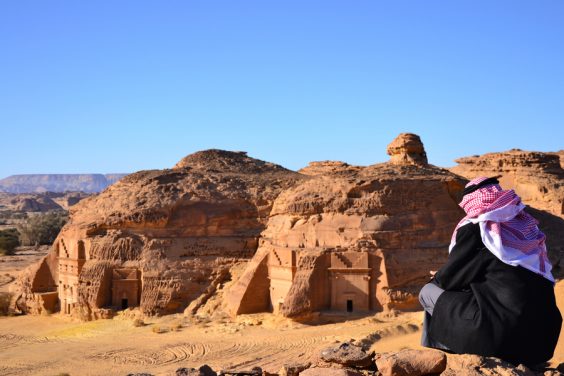Analysts say the kingdom is hoping to promote tourism and national pride by preserving sites predating the rise of Islam
As part of his modernizing agenda, Saudi Arabia’s Crown Prince Mohammed bin Salman is pushing a plan to preserve the kingdom’s pre-Islamic heritage sites, including a date palm oasis from the Stone Age and a 2,000-year-old ancient city resembling Petra in Jordan.
Bin Salman, who is promoting a more moderate form of Islam in the predominantly ultra-conservative country and who last month lifted the decades-long restriction on female drivers, has allocated $1 billion to preserving these and several other heritage sites that predate the rise of Islam in the 7th century.
But analysts have noted that the initiative involves political risk, as the project could very well rankle the kingdom’s Wahhabi establishment that has long dominated the nation. Wahhabism is a rigid strain of Sunni Islam that emerged in Saudi Arabia some 250 years ago. Adherents of this creed regard the veneration of objects—especially those that predate the emergence of the Prophet Mohammed—as idolatry. As such, they advocate neglecting these sites or destroying them altogether.
But the Saudi royal family is working to bridge this divide. Bin Salman’s older half-brother, 62-year-old Prince Sultan bin Salman, heads the Saudi Commission for Tourism and National Heritage. In a recent interview with Reuters, he spoke about ongoing consultations with prominent Muslim scholars about archaeological “discoveries.”
“I believe you cannot understand Islam as a great religion if you are dismissing completely what happened before Islam,” Prince Sultan bin Salman affirmed. “That’s why we focused on hundreds of pre-Islamic sites, pre-history—because this is a story that cannot be understood without being looked at in its own holistic and complete sense.”
One such example is Al-Ahsa, one of the world’s largest natural oases located in eastern Saudi Arabia. Recently named the country’s fifth World Heritage site by the United Nations Educational, Scientific and Cultural Organization (UNESCO), it contains relics that date as far back as the Neolithic period, beginning about 10,200 BCE.
Madain Saleh is another UNESCO site located in northwestern Saudi Arabia. The 2,000-year-old city was created by the Nabateans and features intricate man-made rock carvings and formations which rival those found in Petra.

A view of Madain Saleh. (Wikimedia Commons)
While celebrating these archaeological gems, Prince Sultan bin Salman conceded that up to 150 other important sites have been intentionally ruined or built over with urban structures.
Bill Law, a Middle East analyst and founder of thegulfmatters.com, explained to The Media Line that tourism is an important element of Crown Prince bin Salman’s “Vision 2030,” a reform program intended to modernize and diversify the Saudi economy while weaning the government off its financial dependence on oil exports.
“While most people in the country will support this decision, the conservative religious elite will not be happy,” Law said. But, he qualified, “the crown prince is a very powerful leader and anybody who criticizes him usually ends up in jail.”
While the kingdom has to date benefited from religious tourism, particularly pilgrims who partake in the Hajj, the annual Islamic pilgrimage to Mecca, these pre-Islamic sites are liable to attract a new type of tourist. “This is a new strand of non-religious tourism and entails big opportunities for the crown,” Law said.
He added that if the government hopes to cash in and create private-sector jobs, it will have to modify its entire visa process, starting with providing affordable options for tourists.
Peter Webb, an expert on pre-modern Islamic culture at the University of Leiden, contended to The Media Line that Riyadh’s move is related to its goal of fostering national pride.
“Muslims often portrayed these sites in a negative light—as symbols of bygone times,” Webb said, explaining that they believed God destroyed pre-Islamic civilizations so that the true Islamic faith could rise. But what is interesting about these sites, he continued, is that “they do show a degree of settled civilization in ancient Saudi Arabia. So [whereas] ancient Saudi Arabia is often remembered as period of a bunch of Bedouin who don’t do much except for produce poetry…the Saudi state can now brag about being home to a proper civilized community.”
These ancient populations may have predated Islam, he noted, but the fact that they existed is important for national pride.
“Egypt has its pyramids, Iraq its Mesopotamian past, and Syria its Palmyra…and now Saudi Arabia can promote its pre-Islamic civilization because it shows their land is not just an arid desert that lagged behind European civilization.”